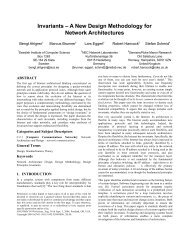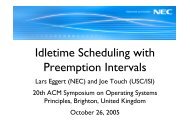Disruption Tolerant Networking - Lars Eggert
Disruption Tolerant Networking - Lars Eggert
Disruption Tolerant Networking - Lars Eggert
Create successful ePaper yourself
Turn your PDF publications into a flip-book with our unique Google optimized e-Paper software.
entation on military satellite communication, Dirk Kutscher et al.’s talk on “Drivethru”<br />
Internet access and Lavy Libman’s disruption prediction for public transportation,.<br />
Finally, a third group of presentations was orthogonal to this division. They include<br />
Per Gunningberg’s experimental testbed for DTN solutions and Hannes Tschofenig’s<br />
security considerations for DTN.<br />
3 Research Questions<br />
One major open question is whether the two areas of work described above – research<br />
related to DTNRG’s bundle-based long-delay architecture on one hand and modifications<br />
to extend current Internet protocols for disruptive environments on the other<br />
hand – are in the end similar enough to be pursued within a combined effort. Although<br />
there are significant overlaps in mechanisms and approaches, the base characteristics<br />
and supported applications differ. Whereas the DTNRG and its related work<br />
focus on scenarios that may never support interactive applications, the main focus of<br />
the latter approaches is to improve the operation of existing, interactive Internet applications<br />
and protocols in situations where network connectivity is intermittent.<br />
One challenge with improving Internet functionality is that the design options are<br />
limited, because of the need to remain compatible with deployed infrastructure and<br />
applications. The DTNRG architecture, on the other hand, has no such restrictions,<br />
because legacy applications are simply unsupported. Consequently, the designers of<br />
DTNRG-related mechanisms are free to evaluate and adopt name/locator, security or<br />
signaling mechanisms that cannot be used in approaches that extend traditional Internet<br />
protocols due to compatibility problems.<br />
Specific questions arose around the issues surrounding whether modifications of<br />
only TCP (called various “TCP hacks”) are an adequate solution to a subset of the<br />
problems of DTN. Although this may be useful for some situations, extended outages<br />
(including those that may span a system reset) will probably not be adequately addressed<br />
solely based on such modifications. Nonetheless, such modifications may<br />
operate in concert with other techniques in addressing more severe disruptions.<br />
The DTNRG has been working on an architecture designed to accommodate a very<br />
wide range of network types, including those with potentially very long delays. The<br />
question was raised as to whether it is realistic to believe this architecture will truly be<br />
able to span such a large variety of networks. It would seem evident that further experience<br />
with the DTNRG architecture may help to answer this question. It may be<br />
instructive to recall, as well, that the Internet architecture has been adopted by a very<br />
wide range of network types and performance characteristics.<br />
The DTNRG architecture generally provides routing based on names, represented<br />
as some form of string. The question was raised as to the difference between names<br />
and addresses. When addresses are not derived from a numbering space that is tied to<br />
the network topology (e.g., cell phone numbers that can roam), names and addresses<br />
can be considered to be effectively equivalent.<br />
Some discussion focused on the issue of how to provide security in networks of<br />
this kind. Most systems, including PKI schemes, are made even more difficult to





